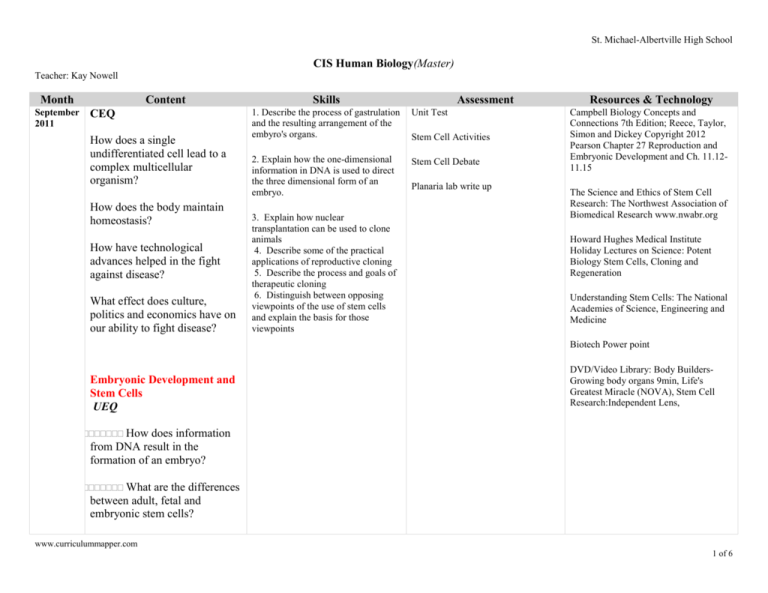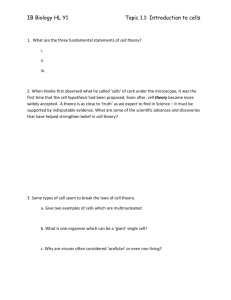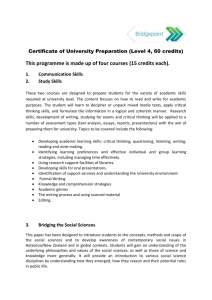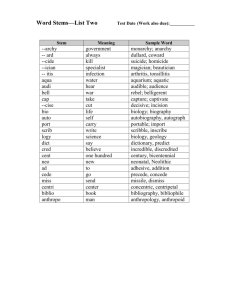Curriculum Map
advertisement

St. Michael-Albertville High School CIS Human Biology(Master) Teacher: Kay Nowell Month September 2011 Content CEQ How does a single undifferentiated cell lead to a complex multicellular organism? How does the body maintain homeostasis? How have technological advances helped in the fight against disease? What effect does culture, politics and economics have on our ability to fight disease? Skills Assessment 1. Describe the process of gastrulation and the resulting arrangement of the embyro's organs. Unit Test 2. Explain how the one-dimensional information in DNA is used to direct the three dimensional form of an embryo. Stem Cell Debate 3. Explain how nuclear transplantation can be used to clone animals 4. Describe some of the practical applications of reproductive cloning 5. Describe the process and goals of therapeutic cloning 6. Distinguish between opposing viewpoints of the use of stem cells and explain the basis for those viewpoints Stem Cell Activities Planaria lab write up Resources & Technology Campbell Biology Concepts and Connections 7th Edition; Reece, Taylor, Simon and Dickey Copyright 2012 Pearson Chapter 27 Reproduction and Embryonic Development and Ch. 11.1211.15 The Science and Ethics of Stem Cell Research: The Northwest Association of Biomedical Research www.nwabr.org Howard Hughes Medical Institute Holiday Lectures on Science: Potent Biology Stem Cells, Cloning and Regeneration Understanding Stem Cells: The National Academies of Science, Engineering and Medicine Biotech Power point Embryonic Development and Stem Cells UEQ DVD/Video Library: Body BuildersGrowing body organs 9min, Life's Greatest Miracle (NOVA), Stem Cell Research:Independent Lens, How does information from DNA result in the formation of an embryo? What are the differences between adult, fetal and embryonic stem cells? www.curriculummapper.com 1 of 6 CIS Human Biology(Master) Nowell Month Content the differences between reproductive technologies and describe their medical potentials St. Michael-Albertville High School Skills Assessment Resources & Technology Explain How do ethical considerations determine which therapies will be pursued? October 2011 Gene Expression and DNA Technologies What is the cellular basis of reproduction and inheritance? How are genes controlled? What is the genetic basis of cancer and how can lifestyle choices reduce the risk? How can DNA technologies be used to improve lives? How do cells age? 1. Explain how gene expression is controlled 2. Explain the significance of the epigenome in terms of environmental changes to the genome and lifestyle choices. 3. Distinguish between the genome and the proteome 4. Explain how viruses, protooncogenes, and tumor-suppressor genes can each contribute to cancer. 5. Describe how telomere length dictates a cell’s life span. 6. Analyze the benefits and risks of emerging DNA technologies Fruit Fly experiments Unit Test Epigenetics activity Campbell Biology Concepts and Connections 7th Edition; Reece, Taylor, Simon and Dickey Copyright 2012 Pearson Chapter 11 How Genes are Controlled and Chapter 12 DNA Technology and Genomics National Institute of Health Curriculum Supplement: Human Genetic Variation Howard Hughes Medical Institute Holiday Lectures on Science: Genomics and Chemical Genetics and The Double Life of RNA HHMI Gene Regulation Guide, HHMI Gene Expression Guide, HHMI Biotechnology Guide Ghost in your Genes epigentics Video and resources NOVA DVD: Genes (Sci. Am Frontiers) Guest Speaker on Genetic Cancer link http://learn.genetics.utah.edu... www.curriculummapper.com 2 of 6 CIS Human Biology(Master) Nowell Month Content Skills St. Michael-Albertville High School Assessment Resources & Technology / http://www.time.com/time/magaz... http://www.sciencemag.org/site... http://epigenome.eu/en/1,1,0 November 2011 Immune System and Disease UEQ How do infectious agents cause disease? What is innate immunity? How does the adaptive immune response counter specific invaders? How can malfunction or failure of the immune system cause disease? 1. Explain the nature of innate defenses 2. Identify the steps of the inflammatory response and how they help to prevent the spread of disease 3. Describe the structure and functions of the lymphatic system 4. Describe the adaptive immune response 5. Define and distinguish between the humoral and cell mediated immune responses 6. Explain how cytotoxic T cells destroy infected body cells 7. Explain why it has been difficult to develop a successful treatment for AIDS 8. Explain how the body distinguishes self from non-self and how this system complicates organ transplantations 9. Describe how the malfunction or failure of the immune system can cause disease. Unit Test Immune system Immune system activities and assignments Campbell Biology Concepts and Connections 7th Edition; Reece, Taylor, Simon and Dickey Copyright 2012 Pearson Chapter 24 Immune System and Disease Infectious Disease Project National Institute of Health Curriculum Supplement: Evolution and Medicine, Confronting the Microbe Menace. AIDS Evolution of an Epidemic HHMI Immunology Guide, The National Center for Case Study Teaching in Science http://sciencecases.lib.buffalo.edu Northwest Association for Biomedical Research: HIV Vaccine Research The Pathophysiology of the Human Immunodeficiency Virus: HIV Curriculum for the Health Professional RX for Survival Disease Warriors DVD and Curriculum www.curriculummapper.com 3 of 6 CIS Human Biology(Master) Nowell Month Content St. Michael-Albertville High School Skills Assessment Resources & Technology Video/DVD Library: AIDS in Africa, Age of AIDS (Frontline), The Link Between Environmental Change and Infectious Disease (Journey to Planet Earth), Race Against the Super Flu, Microkillers Ebola, Influenza 1918 Epidemic, Black Death (not bubonic plague???), Unnatural Causes, Anatomy of a pandemic, Killer Disease on Campus (Meningitis), Vaccines (Frontline), Parasites, Secrets of the Dead Black Death, Ebola Plague Fighters (NOVA), Killer Flu, H5N1 Flu (Primetime), December 2011 Endocrine System UEQ 1. How do hormones affect cells? 2. How are the nervous and the endocrine systems connected? 3. What are the implications of hormone imbalances on the body systems? 1. 2. 3. 4. How do hormone levels change over the course of a lifetime? 4. Aging, Diabetes, Depression, Sleep, Gonads and Sex Hormones, Metabolism, Environmental Hormone Disruptors,Stress and the Adrenal Gland January UEQ 2012 How do neurons receive Compare and contrast the mechanisms and functions of the endocrine and nervous system Unit Test Completion of Case Study Distinguish between the signaling mechanisms of amino-acid-derived hormones and steroid hormones DVD/Video Library: Doping for Gold, Science of the Sexes, Is it a Boy or Girl?, Steroids. Describe the interrelationships between the hypothalamus and the pituitary glands The National Center for Case Study Teaching in Science http://sciencecases.lib.buffalo.edu Explain the role of hormones in: aging, diabetes, depression, sleep, metabolism, stress and aging 1. Describe the structure and function of the subdivisions of the nervous Campbell Biology Concepts and Connections 7th Edition; Reece, Taylor, Simon and Dickey Copyright 2012 Pearson Chapter 26: Hormones and Endocrine System: Unit Test Nervous system Campbell Biology Concepts and Connections 7th Edition; Reece, Taylor, www.curriculummapper.com 4 of 6 CIS Human Biology(Master) Nowell Month Content and process inputs and communicate responses How do neurotransmitters function at the synapse How do drugs act at chemical synapses and how can this lead to addiction? What are the roles of the sympathetic and parasympathetic divisions of the nervous system? How does the limbic system coordinate emotions, memory and learning? How can changes in brain physiology result in neurological disorders? February 2012 EQ will be determined by the instructor at SCSU. The topic changes every year. Skills St. Michael-Albertville High School Assessment Resources & Technology system 2. Describe the structure and functions of neurons and the myelin sheath 3. Explain how an action potential is produced, propagated and returned to resting potential 4. Compare and contrast types and functions of neurotransmitters 5. Explain how drugs can alter chemical synapses 6. Compare the functions of the motor and autonomic nervous systems 7. Compare the structures, functions and interrelationships of the parasympathetic, sympathetic and enteric divisions of the peripheral nervous system. 8. Describe the main parts and functions of the human brain. Detail the structures and functions of the cerebral cortex 9. Explain how the brain regulates sleep and arousal 10. Describe the structure and functions of the limbic system and relate it to how memories are stored. 11. Describe the causes, symptoms and treatments of schizophrenia, depression, Alzheimer’s and Parkinson’s disease Nervous system activities and assignments Simon and Dickey Copyright 2012 Pearson Chapter 28 Nervous Systems Reaction Paper National Institute of Health Curriculum Supplement: Understanding Neurobiology Through the Study of Addiction Compile reseach from primary sources to investigate an issue in human biology. Comprehensive Final Project: Scientific Poster Presentation at SCSU Research Colloquium. Assessment and resources will vary depending on topic, time of year, current events, etc... Create a scientific poster that will be used to convey information on the Neurological Condition Project Comprehensive Final Project: Scientific Poster Presentation at SCSU Research Colloquim. Assessment and resources will vary depending on topic, time of year, current events, etc... Howard Hughes Medical Institute Holiday Lectures on Science: Cancer/Neuroscience: Learning from Patients the science of medicine. Making Your Mind: molecules, motion and memory Sheep brain dissection The National Center for Case Study Teaching in Science http://sciencecases.lib.buffalo.edu DVD library:Football high (head injuries), Blow to the Brain (60 minutes program 13 min), Stress portrait of a killer, Worried Sick (Sci. Am. Frontiers), Placebo Effect (Sci. Am Frontiers), Concussions and Female Athletes, How Does the Brain Work (Nova Science Now), Savants - Accidental Genius, Chess Champions-Brain Wiring, Parkinson's (Frontline), Inside the Teenage Brain (Frontline), Don't Forget Alzheimer's (Sci. Am Frontiers), Alzheimer's, Awakenings Internet resources Guest Instructor www.curriculummapper.com 5 of 6 CIS Human Biology(Master) Nowell Month Content Skills St. Michael-Albertville High School Assessment Resources & Technology selected topic to an audience at research Colloquium. Present the poster and explain in further the poster. www.curriculummapper.com 6 of 6






